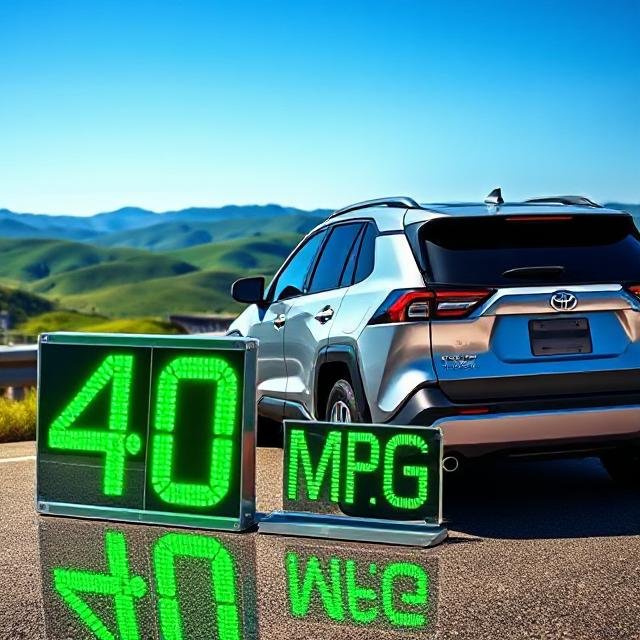The Toyota RAV4 didn’t just invent the compact crossover SUV segment; it has consistently worked to perfect it. For decades, buyers have been drawn to its legendary reliability, practical interior, and comfortable ride. But in today’s world, one metric often rises to the top of the checklist for potential buyers: fuel economy. The question “What is the Toyota RAV4 MPG?” is more than just a number; it’s a crucial factor in the total cost of ownership and environmental footprint. This article will dissect the RAV4’s fuel efficiency across its various powertrains, explore what influences these numbers, and provide a realistic expectation for your daily drive.
Table of Contents
Understanding the MPG Numbers: EPA Estimates vs. The Real World
Before comparing models, it’s vital to understand the source of the official numbers. The fuel economy figures you see on window stickers—like 27 city/35 highway/30 combined—are estimates determined by the Environmental Protection Agency (EPA). These are derived from controlled laboratory tests designed to simulate specific driving conditions.
However, your real-world mileage will vary. Factors like driving style (aggressive acceleration and braking are major culprits), speed (fuel efficiency drops significantly over 60 mph), road conditions (hilly terrain vs. flat highways), weather (cold weather reduces engine efficiency and uses more energy for heating), and even tire pressure can cause your actual MPG to be higher or lower than the EPA estimate.
A Breakdown of the Toyota RAV4 Powertrains and Their MPG
The RAV4’s fuel efficiency isn’t a single number because Toyota offers a range of powertrains designed to balance power, efficiency, and capability. Here’s a detailed look at each.
1. The Gasoline-Powered RAV4 (2.5L 4-Cylinder Engine)
This is the traditional, and most common, powertrain. It features a 2.5-liter Dynamic Force four-cylinder engine that produces ample power for most needs.
- EPA Estimates: Front-Wheel Drive (FWD) models are rated at 27 mpg city / 35 mpg highway / 30 mpg combined.
- Real-World Expectation: Most owners report achieving a combined average very close to the EPA estimate, often landing between 28 and 32 mpg. Gentle highway driving can see numbers in the high 30s, while stop-and-go city traffic might dip into the mid-20s. The key to maximizing efficiency here is smooth, predictable driving.
2. The RAV4 Hybrid
The hybrid model is where the RAV4 truly shines in terms of efficiency. It pairs a 2.5-liter Atkinson-cycle gas engine with two electric motors. The system can operate on electric power alone at low speeds, use the gas engine for highway cruising, or combine both for power when needed, all while seamlessly recharging its battery through regenerative braking.
- EPA Estimates: The Hybrid models, which come standard with Electronic On-Demand All-Wheel Drive (AWD-E), are rated at an impressive 41 mpg city / 38 mpg highway / 40 mpg combined.
- Real-World Expectation: The hybrid often astounds owners with its real-world performance. It’s not uncommon for drivers, especially those in suburban areas with moderate traffic, to meet or even exceed the 40 mpg combined figure. Because its system excels in city driving, where it can frequently use electric power, urban and suburban commuters often see the greatest benefit over the gas model.
3. The RAV4 Prime (Plug-In Hybrid)
The RAV4 Prime is the pinnacle of the lineup, offering the best of all worlds: exceptional electric-only range and stellar hybrid fuel economy. It uses a more powerful version of the hybrid’s powertrain with a larger battery pack that can be plugged in to charge.
- Electric Mode: On a full charge, the Prime can travel an EPA-estimated 42 miles on electric power alone. For most daily commutes and errands, this means you could potentially use zero gasoline.
- Hybrid Mode: Once the battery is depleted, it operates like a highly efficient hybrid. Its EPA rating in hybrid mode is 38 mpg combined.
- Real-World Expectation: Your MPG in the Prime is highly dependent on your driving habits and charging routine. If you have a short commute and can charge nightly, you might go weeks without using a drop of gas. On a long road trip, you’ll get efficiency similar to, or slightly better than, the standard hybrid.
4. The RAV4 Adventure and TRD Off-Road
These trim levels are equipped with a more robust Dynamic Torum Vectoring AWD system designed for improved off-road capability. This system, along with their more aggressive styling and sometimes all-terrain tires, comes with a slight trade-off in fuel efficiency.
- EPA Estimates: These models are rated at 25 mpg city / 32 mpg highway / 27 mpg combined.
- Real-World Expectation: If your driving involves more adventurous pursuits with off-pavement driving, your mileage will understandably be lower. For everyday driving, expect figures in the mid-to-high 20s.
Factors That Directly Impact Your RAV4’s MPG
- Driving Style: This is the single biggest factor. A lead foot is the enemy of good fuel economy.
- AWD vs. FWD: The gas model offers a more efficient FWD option. All hybrids and Primes come standard with AWD, but their system is so efficient that it far surpasses the gas FWD model.
- Tires: Switching from the stock low-rolling-resistance tires to all-terrain or winter tires will typically reduce MPG by 1-3.
- Cargo: Carrying excessive weight, especially on roof racks or cargo carriers that disrupt aerodynamics, will noticeably decrease highway mileage.
- Maintenance: A well-maintained vehicle—clean air filters, proper tire pressure, and timely oil changes—runs more efficiently.
Conclusion: Which RAV4 is the Most Efficient?
The answer is clear: the RAV4 Hybrid is the efficiency champion for the average driver who does not have regular access to charging. It delivers outstanding real-world fuel economy, especially in city driving, and its standard AWD adds value and capability.
For those with a predictable daily drive under 40 miles and access to a plug, the RAV4 Prime offers the ultimate efficiency, potentially eliminating gasoline use for daily needs while retaining hybrid flexibility for longer trips.
The traditional gas model remains a strong and efficient contender in the compact SUV space, particularly in FWD guise, offering a great balance of performance and value. Your choice ultimately depends on your driving patterns, need for AWD, access to charging, and budget.
Informational FAQ Section
Q1: What is the difference between the RAV4 Hybrid and RAV4 Prime?
The RAV4 Hybrid is a self-charging hybrid. It generates all its electricity from its gas engine and regenerative braking. The RAV4 Prime is a plug-in hybrid (PHEV). It has a much larger battery that can be charged from an external outlet, allowing it to drive significant distances on electricity alone before switching to hybrid operation.
Q2: Does the RAV4 Hybrid need to be plugged in?
No, the standard Toyota RAV4 Hybrid does not need to be plugged in. It automatically charges its small battery pack through the engine and by capturing energy during braking and deceleration.
Q3: Is the RAV4 good on gas for long road trips?
Yes, absolutely. The gas model excels on the highway with its 35 mpg rating. The hybrid model is also excellent for road trips, achieving 38 mpg highway. Its hybrid system is efficient at steady highway speeds and provides extra power for climbing hills.
Q4: How does cold weather affect my RAV4’s MPG?
All vehicles see reduced fuel economy in cold weather. Engines take longer to reach their most efficient operating temperature, winter gasoline blends have less energy, and use of heaters, seat warmers, and defrosters increases energy load. Hybrids may see a more noticeable dip as the battery is less efficient in the cold and the gas engine runs more often to provide heat.
Q5: What is the fuel tank capacity of the Toyota RAV4?
The gas models have a 14.5-gallon tank. The Hybrid and Prime models have a slightly smaller 14.5-gallon tank due to packaging with the battery and motors. A larger tank is one reason the gas model can often achieve a longer driving range between fill-ups than the hybrid, despite the hybrid’s superior efficiency.
Q6: Are there any driving modes to help improve fuel economy?
Yes, most RAV4 trims feature an Eco driving mode. When selected, it adjusts the throttle response and climate control system to prioritize efficiency over acceleration. Using Eco mode, especially in city driving, can help maximize your MPG.

